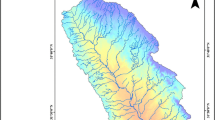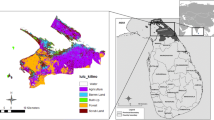Abstract
Water shortage has become a problem in many arid regions where rainfall is low. Wadi Aurnah Basin, in Saudi Arabia (Arabian Peninsula), where the Holy Islamic cities are located, was selected for study, since it represents a water-scarce region. The potential for groundwater storage was investigated. This was achieved using remote sensing and geographic information system (GIS) techniques to cover the whole area (3,113 km2). Satellite images with high spatial resolution were processed to recognize terrain elements controlling the subsurface rock behavior. Landsat 7 ETM+, ASTER and SRTM satellite images were processed using ERDAS IMAGINE software. The influencing factors on groundwater storage were determined and digitally mapped as thematic layers. This included rainfall, lithology, rock fractures, slope, drainage and land cover/use. These factors were integrated in the GIS system (ArcView). A map was produced, indicating potential areas for groundwater storage. The map shows that 12–15% of Wadi Aurnah Basin has potential for groundwater storage, mainly in areas where intensive fracture systems exist.
Résumé
La pénurie d’eau est devenue un problème dans de nombreuses régions arides où la pluviométrie est faible. Le bassin versant de Wadi Aurnah, en Arabie Saoudite (Péninsule Arabique), où les villes sacrées islamiques sont situées, a été sélectionné pour cette étude vu qu’il représente une région pauvre en eau. Le potentiel de stockage des eaux souterraines a été étudié. Ceci a été réalisé en utilisant la télédétection et le système d’information géographique (SIG) pour couvrir l’ensemble du territoire (3,113 km2). Les images satellites à haute résolution spatiale ont été traitées en vue de reconnaître les éléments de terrain qui contrôlent les comportements rocheux souterrains. Landsat 7 ETM +, ASTER et SRTM images satellitaires ont été traitées à l’aide du logiciel ERDAS IMAGINE. Les facteurs influant sur le stockage des eaux souterraines ont été mesurés et cartographiés numériquement sous forme de couches thématiques. Il comprend les précipitations, la lithologie, les fractures de roches, la pente, le drainage, l’utilisation et l’occupation du sol. Ces facteurs ont été intégrés dans le système SIG (ArcView). Une carte a été produite; indiquant les domaines potentiels pour le stockage des eaux souterraines. Cette carte montre que 12–15% du basin de Wadi Aurnah possède un potentiel de stockage des eaux souterraines, principalement dans les zones où les systèmes à forte intensité de rupture existent.
Resumen
La carencia de agua se ha convertido en un problema en muchas regiones áridas donde la precipitación es baja. La cuenca de Wadi Aurnah, en Arabia Saudita (Península Arábiga), donde las ciudades sagradas islámicas están localizadas, fue seleccionada para el estudio, puesto que representa una región de escasez de agua. Se investigó el potencial para el almacenamiento de aguas subterráneas. Esto se logró usando sensores remotos y sistemas de información geográfica (SIG) para cubrir la totalidad del área (3,113 km2). Las imágenes satelitales con alta resolución especial se procesaron para reconocer los elementos del terreno que controlan del comportamiento de rocas subsuperficiales. Imágenes satelitales Landsat 7 ETM+, ASTER y SRTM se procesaron usando el software ERDAS IMAGINE. Se determinaron los factores que influyen en el almacenamiento de las aguas subterráneas y se mapearon digitalmente como capas temáticas. Esto incluyó precipitaciones, litología, fracturas de rocas, pendientes, drenaje y uso/cobertura del suelo. Estos factores fueron integrados en el sistema SIG (ArcView). Se produjo un mapa, indicando áreas potenciales de almacenamiento de aguas subterráneas. El mapa muestra que 12–15% de la cuenca Wadi Aurnah tiene potencial para el almacenamiento de aguas subterráneas, principalmente en áreas donde existen sistemas de fracturación intensiva.
摘要
许多干旱区由于降水少而面临着地下水短缺问题。选择代表缺水地区的伊斯兰圣城所在的沙特阿拉伯 (阿拉伯半岛) Wadi Aurnah盆地作为研究区, 应用遥感和地理信息系统 (GIS) 技术, 调查了全区 (3,113 km2) 地下水的可能储存区域。通过对高空间分辨率卫星图像进行处理, 识别控制地下岩石特性的地形要素。应用ERDAS IMAGINE 软件对Landsat 7 ETM + 、ASTER和SRTM卫星图像进行了处理。确定了地下水储存的影响因素并将其数字化为专题图层。其中包括降水、岩性、岩石裂隙、坡度、渠系和土地覆被/利用。将这些因素由GIS系统 (ArcView) 集成。得到的图件可指示地下水储存的可能区域。该图件表明, Wadi Aurnah盆地的12–15%具有地下水储存潜力, 主要位于裂隙系统发育的地区。
Resumo
A escassez de água tornou-se num problema em muitas regiões áridas com baixa precipitação. A Bacia de Wadi Aurnah, na Arábia Saudita (Península Arábica), onde as cidades Islâmicas Sagradas se localizam, foi seleccionada para ser estudada, visto que representa uma região com escassez de água. Foi investigado o potencial para o armazenamento de água subterrânea. Esta investigação foi conseguida usando técnicas de detecção remota e sistemas de informação geográfica (SIG) para cobrir toda a área (3,113 km2). Imagens de satélite com alta resolução espacial foram processadas para reconhecer elementos do terreno que controlam o comportamento das rochas subsuperficiais. Imagens de satélite do Landast 7 ETM+, ASTER e SRTM foram processadas usando o software ERDAS IMAGINE. Os factores que influenciam o armazenamento da água subterrânea foram determinados e mapeados digitalmente como camadas temáticas. Estes incluíram a precipitação, a litologia, as fracturas das rochas, a inclinação, drenagem e uso ou cobertura do terreno. Estes factores foram integrados num sistema de SIG (ArcView). Foi produzido um mapa indicando as áreas potenciais para o armazenamento de água subterrânea. O mapa mostra que 12–15% da Bacia de Wadi Aurnah tem potencial para o armazenamento de água, sobretudo em áreas onde existem sistemas de fracturação intensa.














Similar content being viewed by others
References
Awari I (2005) Vegetation cover in Wadi Noaman with special emphasis on its tributary: Wadi El Majayrish (in Arabic). MSc Thesis, The University for Women at Jeddah, Saudi Arabia, 473 pp
Ahmed F, Andrawis A, Hagaz Y (1984) Landsat model for groundwater exploration in the Nuba Mountains, Sudan. Adv Space Res 4(11):123–131
Al Saud M (2007) Using satellite imageries to study drainage pattern anomalies in Saudi Arabia. Environ Hydrol J 15(30):1–15
Al Saud M (2008) Using ASTER images to analyze geologic linear features in Wadi Aurnah basin, western Saudi Arabia. Open Remote Sens J 2008(1):17–25
Al Saud M (2009) Morphometric analysis of Wadi Aurnah drainage system, Western Arabian Peninsula. Open Hydrol J 2009(3):1–10
Bilal A, Ammar O (2002) Rainfall water management using satellite imagery: examples from Syria. Int J Remote Sens 23(2):207–219
Congalton G (1991) A review of assessing the accuracy of classifications of remotely sensed data. Remote Sens Environ 37:35–46
Das D (2000) GIS application in hydrogeological studies. Available via http://www.gisdevelopment.net/application/nrm/water/overview/wato0003.htm. Cited March 2010
Darwich T, Kawlie M, Faour G, Masri T, Haddad T, Awad M, Bou Kheir R, Shaban A, Jomaa I, Abdallah C (2003) Dynamic factors of land degradation in Lebanon. Workshop on ecosystem-based assessment of soil degradation to facilitate land users’ and land owners’ prompt action, Adana, Turkey, 2–7 June 2003, Ecoland, Adana, Turkey, pp 66–68
Degnan P, Clark H (2002) Fractured-correlated lineaments at Great Bay, southeastern New Hampshire. US Geol Surv Open-File Rep 02–13, 14, 1 plate
Doll P, Lehner B, Kaspar F (2002) Global modeling of groundwater recharge. Proceedings of the 3rd International Conference on Water Resources and the Environment Research, vol 1. Technical University of Dresden, Germany, pp 27–33
Edet A, Okereke S, Teme C, Esu O (1998) Application of remote sensing data to groundwater exploration: a case study of the Cross River State, southeastern Nigeria. Hydrogeol J 6(3):394–404
El-Baz F (1992) Preliminary observations of environmental damage due to the Gulf war. Nat Resour Forum 16(1):71–75
El-Shazly M, El Raikaiby M, El Kassas A (1983) Groundwater investigation of Wadi Araba area, Eastern Desert of Egypt, using Landsat imagery. Proc. 17th Symp. on Remote Sensing of the Environment. Ann Arbor, Michigan, 9–13 May 1983, Harwood, New York, pp 1003–1113
European Commission (1995) Soil terrain database. Land Management & Natural Hazards Unit. IES and JRC, European Commission, Brussels. Available at: http://eusoils.jrc.ec.europa.eu/projects/SOTER/Soter_Model.html. Cited March 2010
Fetter C (1994) Applied hydrogeology, 3rd edn. Prentice Hall, Englewood Cliffs, NJ, 680 pp
Ganapuram S, Kumar G, Krishna I, Kahya E, Demirel M (2008) Map** of groundwater potential zones in the Musi basin using remote sensing and GIS. Adv Eng Softw 40(7):506518
Girard M-C, Girard C-M (1999) Traitement des données de télédétection [Data processing in remote sensing]. Dunod, Paris, 529 pp
Ghulam A, Qin Q, Zhu L, Abdrahman P (2004) Satellite remote sensing of groundwater: quantitative modeling and uncertainty reduction using 6S atmospheric simulations. Int J Remote Sens 25(23):5509–5524
Gustafsson P (1994) SPOT satellite data for exploration of fractured aquifers in a semi-arid area in Botswana. Hydrogeol J 2(2):9–18
Hariri M (1995) Lineaments studies and fracture control on the Tertiary gold-silver deposits, northern Black Hills, South Dakota, USA, PhD Thesis, South Dakota School of Mines and Technology, USA
Kumar P, Gopinath G, Seralathan O (2007) Application of remote sensing and GIS for the demarcation of groundwater potential areas of a river basin in Kerala, southwest coast of India. Int J Remote Sens 28(24):5583–5601
Meisler H (1963) Hydrogeology of the carbonate rocks of the Lebanon Valley, 4th Series Groundwater Report, W17, Pennsylvania Geological Survey, Harrisburg, PA, 81 pp
Moore TA, AL-Rehaili M (1989) Geological map of Makka Quadrangle, sheet 2 1D. Map GM-107C, Ministry of Petroleum and Mineral Resources, Riyadh, Kingdom of Saudi Arabia,
OFEPR (Organization of Forecast and Environmental Protection Research) (2006) Technical report of climatic data for Makka Al Mukarama, OFEPR, Jeddah, Saudi Arabai
O’Leary D, Friedman J, Poh H (1976) Lineament, linear, lineation: some proposed new standards for old terms. Geol Soc Am Bull (87):1463–1469
Rauch H, LaRiccia M (1978) Water well yield related to lineaments in carbonates and shale of Hagerstown Valley, Maryland. Trans Am Geophys Union 59(4)1–208
Robinson C, El-Baz F, Singhory V (1999) Subsurface imaging by RADARSAT: comparison with Landsat TM data and implications for groundwater in the Selima area, northwestern Sudan. Can J Remote Sens 25(3):268–277
Sahl M (1987) Geology of Makka Al Mukaramah City area. Report DGMR, Deputy Ministry for Mineral Resources, Riyadh, Kingdom of Saudi Arabia, 238 pp
Salman A (1983) Using Landsat image interpretation prospection around Qena providence, Egypt. Int J Remote Sens 4:1497–1489
Sander P, Chesley M, Minor T (1996) Groundwater assessment using remote sensing and GIS in a rural groundwater project in Ghana: lessons learned. Hydrogeol J 4(3):78–93
Savane I, Goze B, Gwyn H (1996) Etude cartographique et structurale à l’aide des données Landsat de la région d’Odienne [Cartographic and structural study using Landsat in the Ivory Coast]. In: Proceedings of the 26th Int. Symp. on Remote Sensing of Environment, Vancouver, BC, 25–29 March 1996, pp 92–97
Seelan K (1983) Satellite data in aid of groundwater exploration: a case study from Karnataka, India. Int. Conf. on Groundwater and Management, Sydney, May 1985, pp 169–173
Sener E, Davraz A, Ozcelik M (2005) An integration of GIS and remote sensing in groundwater investigations: a case study in Burdur, Turkey. Hydrogeol J 13(5):826–834
Shaban A, Khawlie M, Abdallah C (2006) Use of remote sensing and GIS to determine recharge potential zones: the case of occidental Lebanon. Hydrogeol J 14(4):433–443
Su Z (2000) Remote sensing of land use and vegetation for mesoscale hydrological studies. Int J. Remote Sens 21(2):213–233
Taylor L (1980) Fracture traces and water wells: a review. Pennsylvania Geol 11(3):2–4
Teeuw R (1995) Groundwater exploration using remote sensing and a low-cost geographic information system. Hydrogeol J 3(3):21–30
Author information
Authors and Affiliations
Corresponding author
Rights and permissions
About this article
Cite this article
Al Saud, M. Map** potential areas for groundwater storage in Wadi Aurnah Basin, western Arabian Peninsula, using remote sensing and geographic information system techniques. Hydrogeol J 18, 1481–1495 (2010). https://doi.org/10.1007/s10040-010-0598-9
Received:
Accepted:
Published:
Issue Date:
DOI: https://doi.org/10.1007/s10040-010-0598-9




